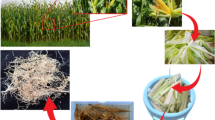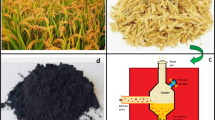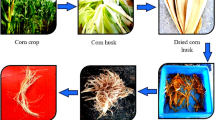Abstract
In this present study for light weight and low-cost engineering applications, high toughness epoxy biocomposites were made using Caryota urens woven (CUW) fibre and coconut husk biochar (CHB) particle. The major goal of this study was to see how adding CHB particles to an epoxy resin composite containing CUW fibre affected the characteristics of the composite. Biochar was made from coconut husk utilizing a low-temperature pyrolysis technique in this study. The composites made with 5% CHB have the maximum tensile strength of 188 MPa. Similarly, a CHB concentration of 7% in epoxy resin reduced wear volume to a higher extent. Furthermore, the composite produced with 7vol. percent CHB had the highest dielectric constant and loss factor of 5.6 and 0.78, and a thermal conductivity of 0.34 W/mK with a larger contact angle of 72°. SEM scans revealed a heavily adherent phase of CHB in the epoxy resin matrix. Electrically stable composites with increased mechanical qualities could be employed in engineering applications such as insulation covers, higher current transmission tunnels, and the automotive industry.






Similar content being viewed by others
References
Merizgui, Tahar, Bachir Gaoui, Tamer A. Sebaey, and VR Arun Prakash. “High content Silver/Zinc oxide nanoparticle and cobalt nanowire in Caryota urens fibre-epoxy composites for enhanced microwave shielding.” Journal of Magnetism and Magnetic Materials 536 (2021): 168118.
Vincent, V. Antony, C. Kailasanathan, G. Ramesh, T. Maridurai, and VR Arun Prakash. “Fabrication and characterization of hybrid natural fibre-reinforced sandwich composite radar wave absorbing structure for stealth radomes.” Transactions on Electrical and Electronic Materials (2021): 1–9.
Merizgui, Tahar, Abdechafik Hadjadj, Bachir Gaoui, Tamer A. Sebaey, VR Arun Prakash, and Mecheri Kious. “High content of siliconized MWCNTs and cobalt nanowire with E-glass/Kenaf fibers as promising reinforcement for EMI shielding material.” Silicon (2021): 1–11.
Manikandan G, Jaiganesh V, Malarvannan Ravi Raja, Prakash Arun VR (2021) Mechanical and delamination studies on siliconized chitosan and morinda-citrifolia natural fiber-reinforced epoxy composite in drilling. Polymer Composites 42(1):181–190
Pandian CK Arvinda, Siddhi Jailani H (2018) Investigation of viscoelastic attributes and vibrational characteristics of natural fabrics-incorporated hybrid laminate beams. Polymer Bulletin 75(5):1997–2014
Palanikumar V, Narayanan V, Vajjiram S (2018) Experimental investigation of mechanical and viscoelastic properties of Acacia Nilotica filler blended polymer composite. Polym Compos 39(7):2535–2546
Arun Prakash, V. R., J. F. Xavier, G. Ramesh, T. Maridurai, K. S. Kumar, and R. B. S. Raj. “Mechanical, thermal and fatigue behaviour of surface-treated novel Caryota urens fibre–reinforced epoxy composite. Biomass Conv Bioref.” (2020).
Shetty Raviraj, Pai Ramamohan, Barboza Augustine BV, Gandhi Viral Pankajkumar (2018) Processing, mechanical charaterization and Its tribological study of discontinuously Reinforced caryota urens fibre Polyester composites. Journal of Engineering and Applied Sciences 13(12):3920–3928
Venkateshwaran N, ElayaPerumal A, Arwin Raj RH (2012) Mechanical and dynamic mechanical analysis of woven banana/epoxy composite. Journal of Polymers and the Environment 20(2):565–572
Suthan R, Jayakumar V, Bharathiraja G (2020) Wear analysis of bio-fillers reinforced epoxy composites. Materials Today: Proceedings 22:793–798
Yamuna Devi S, Grace Annapoorani S (2019) Physical and thermal characterization of natural fibre extracted from Caryota urens spadix fibre. Indian Journal of Fibre & Textile Research (IJFTR) 44(2):193–198
Babu L. Ganesh (2020) INVESTIGATION ON THE MECHANICAL AND MORPHOLOGICAL CHARACTERISTICS OF CARYOTA URENS SPADIX FIBRE REINFORCED WITH POLYESTER COMPOSITES. Journal of the Balkan Tribological Association 26(8):128–169
Das C, Tamrakar S, Kiziltas A, Xie X (2021) Incorporation of biochar to improve mechanical, thermal and electrical properties of polymer composites. Polymers 13(16):2663
Giorcelli M, Bartoli M (2019) Development of coffee biochar filler for the production of electrical conductive reinforced plastic. Polymers 11(12):1916
Fong, T. C., N. Saba, C. K. Liew, R. De Silva, M. Enamul Hoque, and K. L. Goh. “Yarn flax fibres for polymer-coated sutures and hand layup polymer composite laminates.” In Manufacturing of natural fibre reinforced polymer composites, pp. 155–175. Springer, Cham, 2015.
Mahmood Al, Abdullah Abdul Mobin, Morshed Rezwon, Zaman Tasmia (2017) Characterization of glass fibre reinforced polymer composite prepared by hand layup method. American journal of bioscience and bioengineering 5(1):8
Rout Tanmya, Debalaxmi Pradhan RK, Singh NamrataKumari (2016) Exhaustive study of products obtained from coconut shell pyrolysis. Journal of environmental chemical engineering 4(3):3696–3705
Hao Z, Wang C, Yan Z, Jiang H, Huacheng Xu (2018) Magnetic particles modification of coconut shell-derived activated carbon and biochar for effective removal of phenol from water. Chemosphere 211:962–969
Baharum Nor Atikah, Nasir HanisahMohmad, Ishak MohdYusoff, Isa NoorainMohd, Hassan Mohd Ali, Aris Ahmad Zaharin (2020) Highly efficient removal of diazinon pesticide from aqueous solutions by using coconut shell-modified biochar. Arabian Journal of Chemistry 13(7):6106–6121
Krishnan G, Sai L. Ganesh, Babu P, Kumaran G. Yoganjaneyulu, Raj JeganmohanSudhan (2019) Investigation of Caryota urens fibers on physical, chemical, mechanical and tribological properties for brake pad applications. Materials Research Express 7(1):015310
Raju P, Raja K, Lingadurai K, Maridurai T, Prasanna SC (2021) Mechanical, wear, and drop load impact behavior of glass/Caryota urens hybridized fiber-reinforced nanoclay/SiC toughened epoxy multihybrid composite. Polym Compos 42(3):1486–1496
Vasujini, P., W. S. Dandeniya, and R. S. Dharmakeerthi. “Assessing the quality of biochar produced from coconut husk waste.” JOURNAL OF THE SOIL SCIENCE SOCIETY OF SRI LANKA (2014): 21.
Wang J, Wang S (2019) Preparation, modification and environmental application of biochar: a review. J Clean Prod 227:1002–1022
Rajadurai A (2016) Thermo-mechanical characterization of siliconized E-glass fiber/hematite particles reinforced epoxy resin hybrid composite. Appl Surf Sci 384:99–106
Rajadurai A (2017) Inter laminar shear strength behavior of acid, base and silane treated E-glass fibre epoxy resin composites on drilling process. Defence Technology 13(1):40–46
Prakash VR Arun, Viswanthan R (2019) Fabrication and characterization of echinoidea spike particles and kenaf natural fibre-reinforced Azadirachta-Indica blended epoxy multi-hybrid bio composite. Composites Part A: Applied Science and Manufacturing 118:317–326
Dinesh T, Kadirvel A, Vincent Arunprakash (2019) Effect of silane modified E-glass fibre/iron (III) oxide reinforcements on UP blended epoxy resin hybrid composite. Silicon 11(5):2487–2498
Prakash VR Arun, JulyesJaisingh S (2018) Mechanical strength behaviour of silane treated E-glass fibre/Al 6061 & SS-304 wire mesh reinforced epoxy resin hybrid composite. Silicon 10(5):2279–2286
Prakash VR Arun, Viswanathan R (2019) Fabrication and characterization of silanized echinoidea fillers and kenaf fibre-reinforced Azadirachta-indica blended epoxy multi-hybrid biocomposite. International Journal of Plastics Technology 23(2):207–217
Vincent, V. Antony, C. Kailasanathan, V. K. Shanmuganathan, JV Sai Prasanna Kumar, and VR Arun Prakash. “Strength characterization of caryota urens fibre and aluminium 2024-T3 foil multi-stacking sequenced SiC-toughened epoxy structural composite.” Biomass Conversion and Biorefinery (2020): 1–11.
Naik, Prajapati, Samir K. Acharya, Prasanta Sahoo, and Smitirupa Pradhan. “Abrasive wear behaviour of orange peel (biowaste) particulate reinforced polymer composites.” Proceedings of the Institution of Mechanical Engineers, Part J: Journal of Engineering Tribology (2021): 1350650121991412.
Richard, S., J. Selwin Rajadurai, and V. Manikandan. “Effects of particle loading and particle size on tribological properties of biochar particulate reinforced polymer composites.” Journal of Tribology 139, no. 1 (2017).
Giorcelli M, Savi P, Khan A, Tagliaferro A (2019) Analysis of biochar with different pyrolysis temperatures used as filler in epoxy resin composites. Biomass Bioenerg 122:466–471
Khan A, Savi P, Quaranta S, Rovere M, Giorcelli M, Tagliaferro A, Rosso C, Jia CQ (2017) Low-cost carbon fillers to improve mechanical properties and conductivity of epoxy composites. Polymers 9(12):642
Richard S, SelwinRajadurai J, Manikandan V (2016) Influence of particle size and particle loading on mechanical and dielectric properties of biochar particulate-reinforced polymer nanocomposites. International journal of polymer analysis and characterization 21(6):462–477
Torsello D, Bartoli M, Giorcelli M, Rovere M, Arrigo R, Malucelli G, Tagliaferro A, Ghigo G (2021) High frequency electromagnetic shielding by biochar-based composites. Nanomaterials 11(9):2383
Dahal Raj Kumar, Acharya Bishnu, Saha Gobinda, Bissessur Rabin, Dutta Animesh, Farooque Aitazaz (2019) Biochar as a filler in glassfiber reinforced composites: Experimental study of thermal and mechanical properties. Composites Part B: Engineering 175:107169
Bartoli Mattia, Nasir Muhammad Abid, Jagdale Pravin, Passaglia Elisa, Spiniello Roberto, Rosso Carlo, Giorcelli Mauro, Rovere Massimo, Tagliaferro Alberto (2020) Influence of pyrolytic thermal history on olive pruning biochar and related epoxy composites mechanical properties. Journal of composite materials 54(14):1863–1873
Strongone V, Bartoli M, Jagdale P, Arrigo R, Tagliaferro A, Malucelli G (2020) Preparation and characterization of UV-LED curable acrylic films containing biochar and/or multiwalled carbon nanotubes: effect of the filler loading on the rheological, thermal and optical properties. Polymers 12(4):796
Thiyagu, T. Thendral, Sai Prasanna Kumar JV, V. Sathiyamoorthy, and Arun Prakash VR. “Effect of cashew shell biomass synthesized cardanol oil green compatibilizer on flexibility, barrier, thermal, and wettability of PLA/PBAT biocomposite films.” Biomass Conversion and Biorefinery (2021): 1–11.
Selvaraj V, Raghavarshini TR, Alagar M (2021) Design and development of bio-carbon reinforced hetero structured biophenolics polybenzoxazine-epoxy hybrid composites for high performance applications. J Polym Res 28(5):1–13
Ighalo Joshua O, Igwegbe ChinenyeAdaobi, Adeniyi Adewale George, Abdulkareem Sulyman A (2021) Artificial neural network modeling of the water absorption behavior of plantain peel and bamboo fibers reinforced polystyrene composites. Journal of Macromolecular Science, Part B 60(7):472–484
Acknowledgements
The corresponding author of this research deeply appreciates the support received from the “Metro Composites, Chennai, India”, in material procurement and characterization.
Author information
Authors and Affiliations
Corresponding author
Ethics declarations
Conflict of interest
The authors declare no competing interests.
Additional information
Publisher's note
Springer Nature remains neutral with regard to jurisdictional claims in published maps and institutional affiliations.
Rights and permissions
About this article
Cite this article
Prabhu, P., Jayabalakrishnan, D., Balaji, V. et al. Mechanical, tribology, dielectric, thermal conductivity, and water absorption behaviour of Caryota urens woven fibre-reinforced coconut husk biochar toughened wood-plastic composite. Biomass Conv. Bioref. 14, 109–116 (2024). https://doi.org/10.1007/s13399-021-02177-3
Received:
Revised:
Accepted:
Published:
Issue Date:
DOI: https://doi.org/10.1007/s13399-021-02177-3




